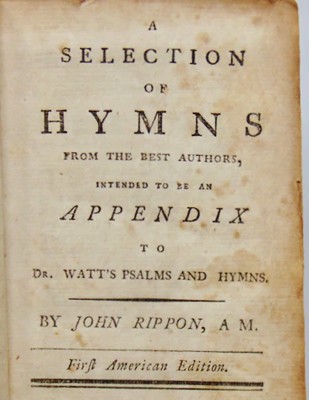The Story Behind: How Firm a Foundation
How Firm a Foundation tells the message of human trials and the need for a perfect Savior. Only that message – the Gospel message – could give peace to dying men and unite the bitterest of foes, which is exactly what this Christian hymn has done.
Publication and Rise in Popularity

How Firm a Foundation first reached the public when John Rippon – an influential English minister who pastored Carter Lane Baptist Church in London – published A Selection of Hymns from the Best Authors in 1787. This collection featured a variety of hymns that Rippon found to be especially powerful, which turned out to be true as the collection quickly rose in popularity. In fact, the collection was so popular that eleven different editions were released between the time of original release and Rippon’s death in 1836. One such edition made its way to America, and specifically to Baptist Churches in Philadelphia. As popular as the collection was in England, it was perhaps more-so in America, and even became known as the ‘unofficial hymnbook for Baptist Churches.’
Mystery of the Hymn’s Authorship
The authorship of How Firm a Foundation remains a mystery to this day. The hymn first appeared in Rippon’s popular compilation, which carefully credited authors for most works. However, for How Firm a Foundation, the only initial attribution was “K-”. Later editions evolved to “Kn” and then “Keen,” hinting at but never confirming the lyricist’s identity. An 1844 edition even credited “Kirkham,” showing the ongoing uncertainty around the hymn’s origin. The Dictionary of Hymnology from 1907 states that Daniel Sedgwick, a London bookseller and hymnology enthusiast in the 1800s, suggested George Keith as the possible author.
One speculated contributor is Robert Keene, a close friend of John Rippon who served as song leader at Carter Lane Church from 1776-1793. Some historians believe Keene likely assisted Rippon in preparing his influential hymnal. However, no texts are definitively credited to Keene in early editions. Six tunes bear his name, suggesting he composed music but not words. This fits practices of the time, as hymnal compilers then did not consistently identify authors. While Keene probably contributed tunes, firm evidence that he authored the hymn remains elusive.
Historical Significance of the Hymn
Though the author was unknown, the hymn survived through its great message. It was especially popular with men who felt the weight of the world on their shoulders, and many leaders in America chose it as their favorite hymn. Andrew Jackson requested it be sung at his deathbed, and Robert E. Lee and Theodore Roosevelt both requested it be sung at their funerals. During the American Civil War, both Northern and Southern soldiers could be heard singing it; a testament to how God bridges the gap between all men.
In 1898, How Firm a Foundation was used to united a divided American army. It happened during the Spanish-American war, a time soon after the Civil War when tensions between North and South were still high. Soldiers needed to put aside differences to face a new conflict, but that was easier said than done. Lieutenant-Colonel Curtis Guild Jr. was there on the night it happened, and here is his account:
On Christmas eve of 1898 I sat before my tent in the balmy tropical night [near Havana] chatting with a fellow-officer of Christmas and home.
Suddenly from the camp of the Forty-ninth Iowa rang a sentinel’s call, “Number ten; twelve o’clock, and all’s well!” It was Christmas morning. Scarcely had the cry of the sentinel died away, when from the bandsmen’s tents of that same regiment there rose the music of an old, familiar hymn, and one clear baritone voice led the chorus that quickly ran along those moonlit fields: ‘How firm a foundation, ye saints of the Lord!’
Another voice joined in, and another, and another, and in a moment the whole regiment was singing, and then the Sixth Missouri joined in, with the Fourth Virginia, and all the rest, till there, on the long ridges above the great city whence Spanish tyranny once went forth to enslave the New World, a whole American army corps was singing –
Fear not, I am with thee, O be not dismayed;
For I am thy God, and will still give thee aid;
I’ll strengthen thee, help thee and cause thee to stand,
Upheld by My righteous, omnipotent hand.
The hymn originally contained seven stanzas of four lines each. Modern hymnals typically include five of these original stanzas, with only minor alterations to the text. The opening verse establishes these as words of promise directly from Jesus Christ. Verses two through five read as though they are Jesus’ own words, even though many of the Scriptural allusions actually come from the Old Testament.
Lyrics and Biblical References
Hymn scholar Albert Bailey carried out a detailed analysis of the biblical references within the hymn. He found that stanza two closely mirrors Isaiah 41:10, which states “Fear thou not; for I am with thee: be not dismayed; for I am thy God: I will strengthen thee; year, I will help thee; yea, I will uphold thee with the right hand of my righteousness” (KJV). The final stanza primarily draws language from Deuteronomy 31:6 and 8, which offers reassurance: “Be strong and of a good courage, fear not, nor be afraid of them: for the LORD thy God, he it is that doth go with thee; he will not fail thee, nor forsake thee…. he it is that doth go before thee; he will be with thee, he will not fail thee, neither forsake thee: fear not, neither be dismayed.” This sermon in song’s lasting power stems from its masterful blending of unchangeable Scriptural promises into an expression of God’s faithfulness.
The Enigma of the Hymn Tune: FOUNDATION
Yet another mystery surrounds a key piece of the puzzle – the origin of its iconic folk tune, now called FOUNDATION. This anonymous melody first appeared alongside the hymn text in Joseph Funk’s 1832 Genuine Church Music collection under the name “Protection.” After careful analysis, hymnologist Harry Eskew concluded that “Protection” was previously unpublished and thus a new composition at the time. Earlier American hymnals had often paired How Firm a Foundation with the tune ADESTE FIDELIS, indelibly associated with O Come, All Ye Faithful. But the new hymn tune now known as FOUNDATION quickly stuck and became forever linked with the hymn, even as the identity of its composer remains unknown.
Nevertheless, FOUNDATION endures as an exemplar of early American folk hymnody. This grassroots musical tradition shaped worship in countless churches and camp meetings, where simple, singable tunes paired perfectly with texts proclaiming the basic Gospel message. The timeless appeal of FOUNDATION played no small part in cementing How Firm a Foundation as a pillar of Protestant hymnody on both sides of the Atlantic. Its composer may be forgotten, but the folk melody continues to anchor a beloved hymn.
Frequently Asked Questions (FAQ)
What was the original title of How Firm a Foundation?
When it first appeared in John Rippon’s 1787 hymnal, it was untitled, referring to its opening line “How Firm a Foundation.” Titling by the first line was common then. The tune was originally called PROTECTION when paired with the hymn in 1832, later changing to FOUNDATION.
Who wrote the hymn How Firm a Foundation?
The author of this beloved hymn remains unknown. It first appeared anonymously in 1787 in John Rippon’s popular hymnal. Some have speculated his friend Robert Keene assisted, but no definitive evidence exists. The original lyricist’s identity has been lost to history, though the hymn lives on.
Download sheet music, chord charts, tracks and instrumental parts exclusively with a hymncharts subscription.


